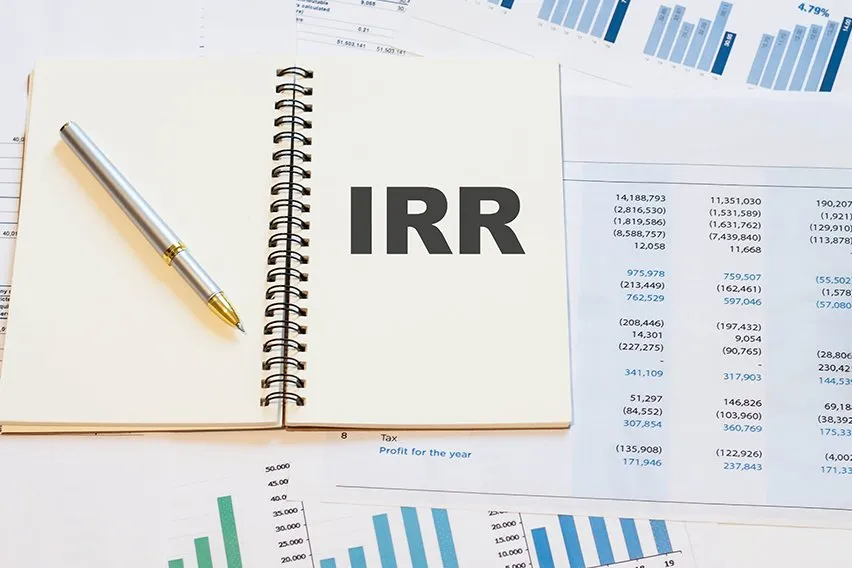Internal Rate of Return (IRR): Definition & Formula Guide

Do you want to know how much money your investment will make?
Internal rate of return is a method of financial analysis. It is a metric that tells you the rate at which your investment will grow over time. It’s also one of the most important numbers in finance. It helps us decide whether to stay invested in a project or liquidate sooner.
IRR is an accurate way to measure just how profitable something can be over time. This number gives us valuable information about what our investments are really worth. This article will discuss all about IRR. It will include topics like what IRR means, how to use IRR and more.
Here’s What We’ll Cover:
What Is the Internal Rate Of Return?
How to Calculate Internal Rate of Return (IRR)
Which Industries Benefit the Most From IRR Analysis?
What are Good and Bad Internal Rates of Return?
What Is the Internal Rate Of Return?
Internal rate of return (IRR) is a tool that analysts use to determine what an investment will be worth over time. IRR helps you measure the profitability of projects and make informed decisions based on your investments.
It’s critical in many different types of financial analysis. This is especially true for comparing various investments like stocks vs. mutual funds. It’s also very prevalent in real estate investing.

How to Calculate Internal Rate of Return (IRR)
IRR is a financial metric that tells you how much money your investment will make in the long run. The formula for IRR looks very daunting. We would recommend using an online calculator like this one – https://www.calculatestuff.com/financial/irr-calculator – to calculate your return.
You’ll need to input your initial investment amount and your negative and positive cash flow for subsequent years. Using these numbers, you can complete your calculation.
What Does an IRR Calculation Actually Tell You?
What does your IRR calculation actually mean? Internal rate of return is the rate of return you will make on an investment. This number can be compared to other investments.
The higher the internal rate of return, the better the deal will be for you. Getting a high percentage means that you are earning more money than if you invested in other opportunities.
The true benefit of IRR is that it tells you specific points in time that your investment may be best. Based on your future cash flows, you may find it’s actually more profitable to exit an investment sooner. This is one of the reasons why IRR is so popular in the real estate industry.
The Rule of IRR
The internal rate of return (IRR) rule says that an investment should be considered further if the internal rate of return is greater than the minimum required rate of return. This minimum acceptable rate is known as the hurdle rate. This could be set by your industry or on an individual basis. The IRR rule is a loose rule and sometimes it’s not always followed by investors. It should be considered as a starting point, not a deciding factor.
Which Industries Benefit the Most From IRR Analysis?
The industries that benefit most from IRR analysis are real estate and medical. These are areas of high capital spending. We also rely more on these investments over time. This is why it’s important to use this metric for these types of projects.
For example, say you own a rental property. You paid $100,000 and it generates $6,000 per year In a series of cash flows. You hold this property for 5 years, collecting your $6,000 in cash flow each year. In year five, you sell for the same $100,000 you paid. If we plug this into the calculator, you’ll see you get a 6% IRR.
Now, it’s up to you whether this is acceptable or not. For many investors, a 6% return on investment is not good enough. They may seek an alternative investment. In this example, you can see how important appreciation becomes. While a steady profit is commendable, you can likely find other investments with better returns.
IRR Compared
The Difference between IRR and Projected Rate of Return
Internal Rate of Return isn’t the same as a Projected Rate of Return. This is another term that investors use to measure investments. A projected rate of return will consider all future data, including future returns on an asset.
It’s possible for your IRR to be helpful with your projections. For example, if you are using an expected rate of return for a certain asset, you could calculate the IRR. The difference between the two numbers tells you how much money you are losing or gaining by investing in another opportunity.
IRR has become a standard in the financial industry for this reason. You can use it as a tool to compare investments and make decisions based on your rate of return. Understanding how this metric works may help you to invest your money smartly.
IRR vs NPV
NPV stands for Net Present Value. This metric is used to compare investments with a lot of positive and negative cash flow involved. Often, you’ll see NPV in conjunction with IRR when evaluating an investment.
IRR tells you how much money your investment will make in the long run. It doesn’t take into account future values or timing effects. NPV takes all of this into consideration. NPV uses a discount rate to assess the value of your future returns.
IRR vs Modified Internal Rate of Return (mIRR)
mIRR is a modified version of IRR. This metric allows the company to set a limit for their growth rates, reducing risk in an investment. It’s essentially an adjustable ROI that businesses can use to customize results in accordance with their needs.
Unlike traditional IRR, mIRR uses a constant growth rate in its calculations. This number will vary depending on the company, industry and many other factors.
The main difference here is that you can use mIRR to give a more accurate depiction of the ROI. Using your set growth percentage, you can better determine how the investment in question stacks up against projected return rate.
The Downsides of IRR
One of the main problems with internal rate of return is that it’s rather simple. This can often lead to incorrect measurement. Each investment will have different math involved, affecting the way you should use this metric.
For example, if you are using IRR to measure an IPO stock, you may see a large number for your expected returns. This isn’t accurate because of the market’s volatility. It may be years before you see the returns that are being projected.
Another downside of IRR is that it’s hard to determine the quality of an investment. This is because this metric considers all cash flows, both positive and negative. While it’s good for seeing overall returns on an investment, you won’t see accurate data for each cash flow type.
While IRR can be helpful for comparing investments, there are many factors that go into determining the best investments. Using this metric is no substitute for thorough research and data collection.
What are Good and Bad Internal Rates of Return?
A good rate of return for an investor will depend on several factors. Some investors will require a higher percentage than others. There are certain standards that you can use as a guide.
If an investment has an IRR below 10%, many financiers would not be interested in it. A riskier investment may have an IRR over 20%. Very conservative investments could see rates as low as 5%.
If you’re looking to invest your money, knowing the standard range of IRR can help you to make better decisions. Understanding what these numbers mean can give you an idea of how secure your investment is.
Once you’ve chosen the investment, you can use IRR to determine what kind of money you can make on it. For example, if you are looking at two investments with different rates of return, IRR may help you to choose the one that’s more beneficial for your personal situation.

Why Should You Use IRR?
Internal rate of return can be a very useful metric. It helps you to measure the expected ROI of an investment. Before determining your final decision, IRR can help you to get a better idea of what kind of money you should make from it.
IRR is also beneficial because it takes into account all cash flows associated with an investment. This means that you will get a better idea of long-term returns. It doesn’t matter what stage the cash flow is in, as long as it still has some value to contribute.
In cases where multiple IRRs are being generated from an investment, this metric can help you to find the most accurate one. Using more than one rate of return can help you to get a clear picture of what kind of return you can expect from your investment.
IRR also helps with comparing investments. It’s easy to see which one is more beneficial by comparing the rates that are being generated. IRR may be complicated, so it’s typically best to just use an online calculator.
Internal Rate of Return is Useful for Assessing Investments
While internal rate of return has its problems, it is still an important metric to consider when making investments. If you have more than one option, IRR can help you to pick the best one.
Although many investors will rely on other factors, this metric can often be useful for making quick comparisons of investments. When using IRR, it’s important to consider how you are using this number and why. Whether you are looking at long-term or short-term returns, knowing what is considered a standard return can help you to make more informed decisions.
Key Takeaways
The Internal Rate of Return (IRR) is a metric that can be used to measure the expected return on an investment. IRR accounts for all cash flows, both positive and negative, associated with an investment. This provides you with more accurate data about your investments over time. It’s important when calculating IRRs to use one consistent method. This ensures that numbers are comparable across different industries or projects.
The standard range for this metric falls between 5-20%+ depending on how conservative your investor is willing to be. If you’re looking into investing money, knowing what these values mean will help you make better decisions. IRR can help you understand which investments may have more risk than others.
IRR is an important financial number. It has been used for a long time in many industries. Hopefully this article answers your questions about IRR!
If you’re looking for more information like this, visit our resource hub!
RELATED ARTICLES

 What Is an Outstanding Deposit?
What Is an Outstanding Deposit? Production Volume Variance: Definition, Formula & Example
Production Volume Variance: Definition, Formula & Example What Is Off-Balance Sheet Financing? Definition & Example
What Is Off-Balance Sheet Financing? Definition & Example What Are Retained Earnings? Definition, Examples & Calculation
What Are Retained Earnings? Definition, Examples & Calculation Cost Method: An Accounting Guide
Cost Method: An Accounting Guide What Is TTM (Trailing Twelve Months) in Finance?
What Is TTM (Trailing Twelve Months) in Finance?